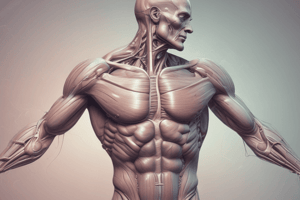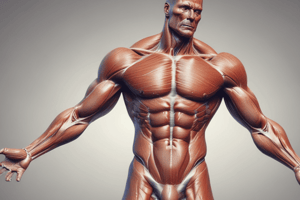Podcast
Questions and Answers
Which function of the muscular system directly contributes to changes in the volume of the chest cavity during breathing?
Which function of the muscular system directly contributes to changes in the volume of the chest cavity during breathing?
- Respiration (correct)
- Circulation
- Digestion
- Urination
What is the primary role of smooth muscles in the circulatory system?
What is the primary role of smooth muscles in the circulatory system?
- Assisting in maintaining posture
- Regulating blood flow through arteries and veins (correct)
- Facilitating gross motor movement.
- Controlling the digestion
Which type of muscle is characterized as striated and under voluntary control?
Which type of muscle is characterized as striated and under voluntary control?
- Skeletal muscle (correct)
- Cardiac muscle
- Smooth muscle
- Urinary muscle
Peristalsis, facilitated by smooth muscles, is essential for which bodily function?
Peristalsis, facilitated by smooth muscles, is essential for which bodily function?
The coordinated function of smooth and skeletal muscles is crucial for which process?
The coordinated function of smooth and skeletal muscles is crucial for which process?
If a person is standing perfectly still, which function of the muscular system is primarily responsible for maintaining this posture?
If a person is standing perfectly still, which function of the muscular system is primarily responsible for maintaining this posture?
Which of the following muscle types is found in the heart and is responsible for pumping blood?
Which of the following muscle types is found in the heart and is responsible for pumping blood?
Which muscle type is also known as 'involuntary'?
Which muscle type is also known as 'involuntary'?
Flashcards
Physiology
Physiology
The study of the functions of the human body and its mechanisms.
Mobility via Muscles
Mobility via Muscles
Muscles contract for gross and fine movement.
Posture
Posture
Skeletal muscles help maintain body position while sitting or standing.
Muscles in Circulation
Muscles in Circulation
Signup and view all the flashcards
Respiration & Diaphragm
Respiration & Diaphragm
Signup and view all the flashcards
Digestion Muscles
Digestion Muscles
Signup and view all the flashcards
Muscles in Urination
Muscles in Urination
Signup and view all the flashcards
Skeletal Muscle
Skeletal Muscle
Signup and view all the flashcards
Study Notes
- Section 1 focuses on the physiology of muscle tissues.
- Objectives include defining physiology, describing the functions of the muscular system, and identifying different types of muscles.
Defining Physiology
- Physiology is the study of the functions and mechanisms of the human body.
Functions of the Muscular System
- Mobility occurs when muscles contract, contributing to gross and fine movements.
- Posture is maintained by skeletal muscles, helping keep the body in the correct position when sitting or standing.
- Circulation involves the heart pumping blood throughout the body.
- Smooth muscle in the arteries and veins plays a role in blood circulation.
- Respiration occurs when the diaphragm contracts, pushing downwards and enlarging the chest cavity, allowing the lungs to fill with air.
- When the diaphragm muscle relaxes, it pushes air out of the lungs.
- Digestion involves smooth muscles in the gastrointestinal tract controlling the process.
- Food moves through the digestive system through peristalsis, a wave-like motion.
- Muscles in the walls of hollow organs contract and relax, pushing food through the oesophagus into the stomach.
- Digested food moves from the stomach to the intestines through peristalsis.
- More muscles contract to pass stool out of the body.
- Urination requires the urinary system which comprises both smooth and skeletal muscles.
- Muscles and nerves work together to hold and release urine from the bladder.
Types of Muscles
- Three types include skeleton, smooth and cardiac.
- Skeletal muscles are striated and voluntary.
- Smooth muscles are non-striated, involuntary, and plain.
- Cardiac muscles are striated and involuntary.
Studying That Suits You
Use AI to generate personalized quizzes and flashcards to suit your learning preferences.




